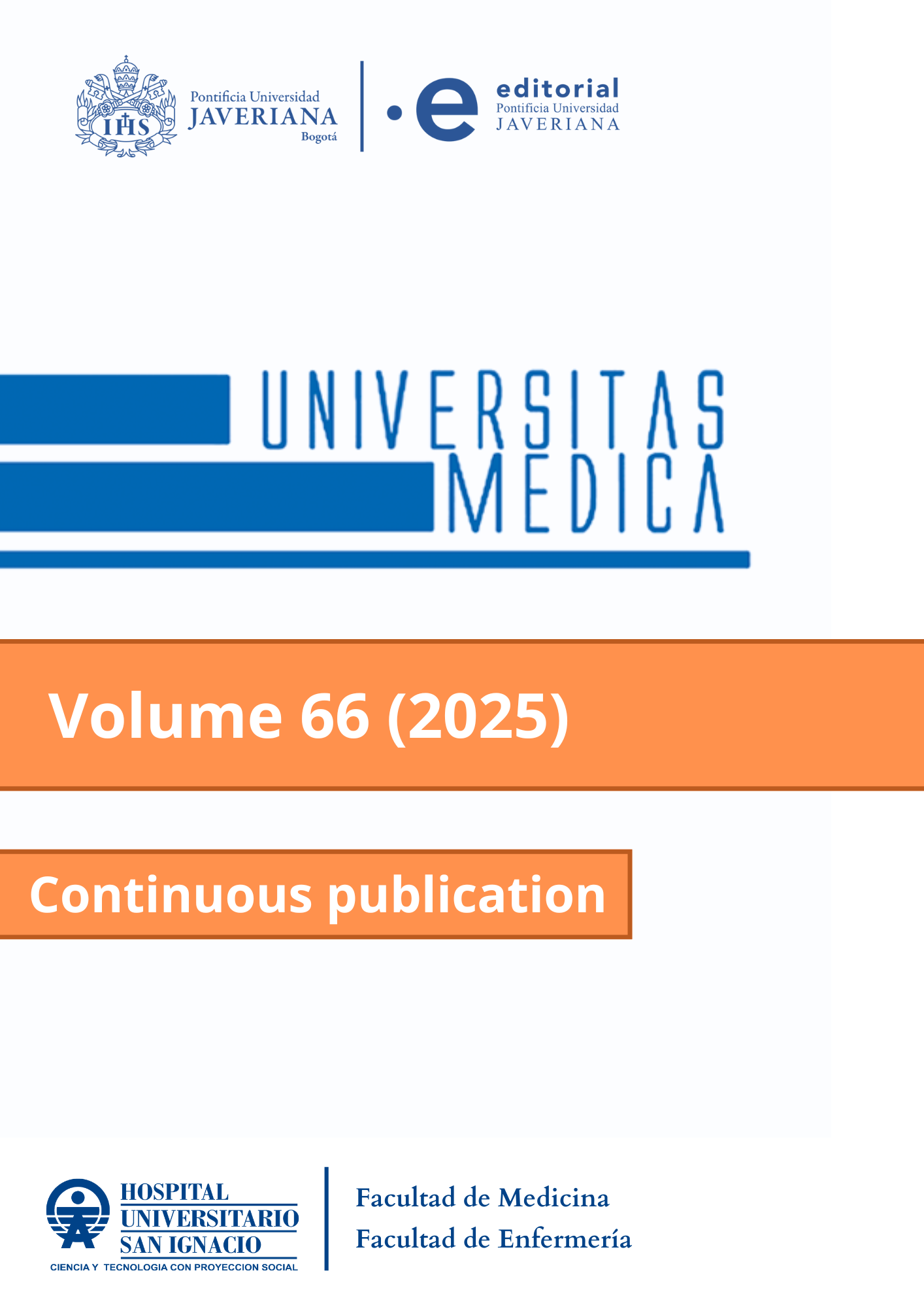Resumen
Introducción: Durante la estancia de los pacientes en la unidad de cuidado intensivo (UCI), los médicos encargados de su cuidado se pueden enfrentar a la necesidad de retiro de soportes vitales, como lo es el soporte ventilatorio. Objetivo: evaluar la percepción de los médicos que trabajan en UCI en Colombia sobre la extubación paliativa y los factores que influyen en su toma de decisiones. Metodología: Aplicación de una encuesta autoaplicada, realizada a 36 médicos de diversas especialidades. Se analizaron aspectos sociodemográficos, percepciones éticas y legales, y la influencia de la espiritualidad en la suspensión de la ventilación mecánica. Resultados: La mayoría de los encuestados son médicos intensivistas, hombres, con menos de cinco años de experiencia en UCI. En términos de decisión clínica, el 92 % de los participantes considera que la limitación o suspensión de tratamientos es una parte fundamental del ejercicio médico en UCI y que debe aplicarse sin importar la patología subyacente. En cuanto a la técnica de retiro de la ventilación mecánica, la mayoría (50 %) opta por el destete terminal; mientras que un menor porcentaje (5,6 %) percibe la extubación terminal como una práctica ilegal. El estudio también reveló que la religiosidad y la espiritualidad desempeñan un papel relevante en la toma de decisiones médicas. Conclusiones: Los resultados cuantitativos mostraron una considerable variabilidad en la percepción médica sobre la extubación paliativa, particularmente en función de la especialidad y las creencias religiosas.
1. Ortega-Chen C, Van Buren N, Kwack J, Mariano JD, Wang SE, Raman C, et al. Palliative extubation: a discussion of practices and considerations. J Pain Symptom Manage. 2023 Aug;66(2):e219-31. https://doi.org/10.1016/j.jpainsymman.2023.03.011
2. Robert R, Le Gouge A, Kentish-Barnes N, Cottereau A, Giraudeau B, Adda M, et al. Terminal weaning or immediate extubation for withdrawing mechanical ventilation in critically ill patients (the ARREVE observational study). Intensive Care Med. 2017 Dec;43(12):1793-807. https://doi.org/10.1007/s00134-017-4891-0
3. Ay E, Weigand MA, Röhrig R, Gruss M. Dying in the intensive care unit (ICU): a retrospective descriptive analysis of deaths in the ICU in a communal tertiary hospital in Germany. Anesthesiol Res Pract. 2020 Mar 1;2020:2356019. https://doi.org/10.1155/2020/2356019
4. Stamper TO, Kerr R, Sporter D. The evolution of palliative medicine in intensive care. Crit Care Nurs Q. 2022;45(4):332-8. https://doi.org/10.1097/CNQ.0000000000000425
5. Cottereau A, Robert R, le Gouge A, Adda M, Audibert J, Barbier F, et al. ICU physicians’ and nurses' perceptions of terminal extubation and terminal weaning: a self-questionnaire study. Intensive Care Med. 2016 Aug;42(8):1248-57. https://doi.org/10.1007/s00134-016-4373-9
6. Faber-Langendoen K. The clinical management of dying patients receiving mechanical ventilation. Chest. 1994 Sep;106(3):880-8. https://doi.org/10.1378/chest.106.3.880
7. McAree SJ, Doherty PA. A survey regarding physician preferences in end-of-life practices in intensive care across Scotland. J Intensive Care Soc. 2010 Jul;11(3):182-6. https://doi.org/10.1177/175114371001100308
8. Flannery L, Ramjan LM, Peters K. End-of-life decisions in the intensive care unit (ICU): exploring the experiences of ICU nurses and doctors. A critical literature review. Aust Crit Care. 2016 May;29(2):97-103. https://doi.org/10.1016/j.aucc.2015.07.004
9. Azoulay E, Metnitz B, Sprung CL, Timsit JF, Lemaire F, Bauer P, et al. End-of-life practices in 282 intensive care units: data from the SAPS 3 database. Intensive Care Med. 2009 Apr;35(4):623-30. https://doi.org/10.1007/s00134-008-1310-6
10. Jox RJ, Schaider A, Marckmann G, Borasio GD. Medical futility at the end of life: the perspectives of intensive care and palliative care clinicians. J Med Ethics. 2012 Sep;38(9):540-5. https://doi.org/10.1136/medethics-2011-100479
11. Sprung CL, Cohen SL, Sjokvist P, Baras M, Bulow HH, Hovilehto S, et al. End-of-life practices in European intensive care units: the Ethicus Study. JAMA. 2003 Aug 13;290(6):790-7. https://doi.org/10.1001/jama.290.6.790
12. Wenger NS, Carmel S. Physicians’ religiosity and end-of-life care attitudes and behaviors. Mt Sinai J Med. 2004 Oct;71(5):335-43. PMID: 15543435
13. Thellier D, Delannoy PY, Robineau O, Meybeck A, Boussekey N, Chiche A, et al. Comparison of terminal extubation and terminal weaning as mechanical ventilation withdrawal in ICU patients. Minerva Anestesiol. 2017 Apr;83(4):375-82. https://doi.org/10.23736/S0375-9393.16.11468-3
14. Shalman D. Clinical outcomes of a joint ICU and palliative care multidisciplinary rounding model: A retrospective cohort study. PLoS One. 2024 Feb 1;19(2):e0297288. https://doi.org/10.1371/journal.pone.0297288
15. Ma J, Chi S, Buettner B, Pollard K, Muir M, Kolekar C, et al. Early palliative care consultation in the medical ICU: a cluster randomized crossover trial. Crit Care Med. 2019 Dec;47(12):1707-15. https://doi.org/10.1097/CCM.0000000000004016
16. Helgeson SA, Burnside RC, Robinson MT, Mack RC, Ball CT, Guru PK, et al. Early versus usual palliative care consultation in the intensive care unit. Am J Hosp Palliat Care. 2023 May;40(5):544-51. https://doi.org/10.1177/10499091221115732
17. Martins BDCPCC, Oliveira RA, Cataneo AJM. Palliative care for terminally ill patients in the intensive care unit: systematic review and metaanalysis. Palliat Support Care. 2017 Jun;15(3):376-83. https://doi.org/10.1017/S1478951516000584

Esta obra está bajo una licencia internacional Creative Commons Atribución 4.0.
Derechos de autor 2025 Melissa Reyes Rueda, Alejandrina Martínez Orjuela, Nelson Francisco Castañeda Alarcón



